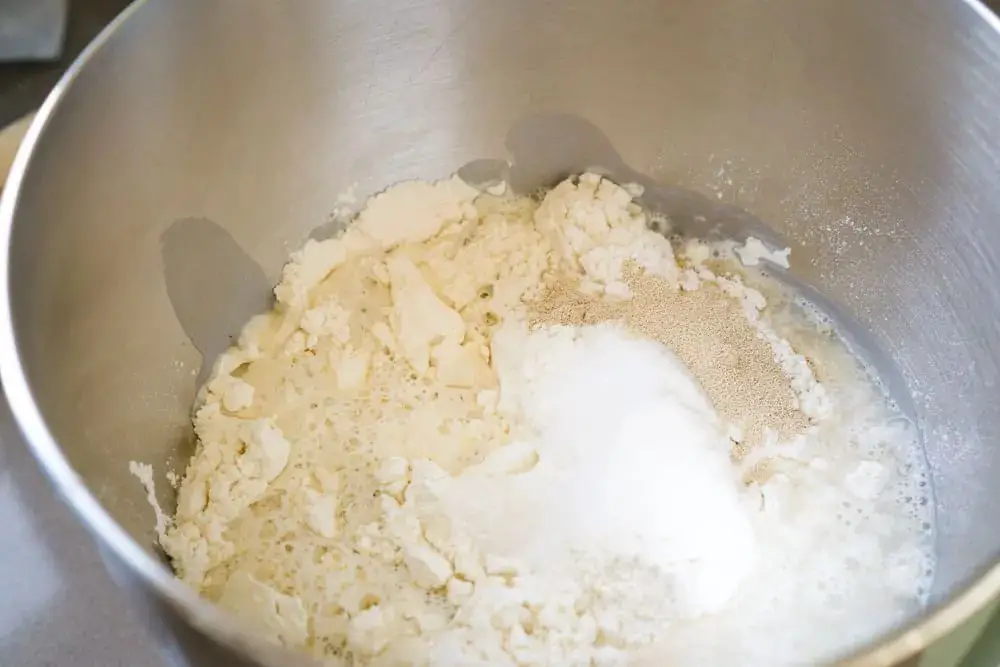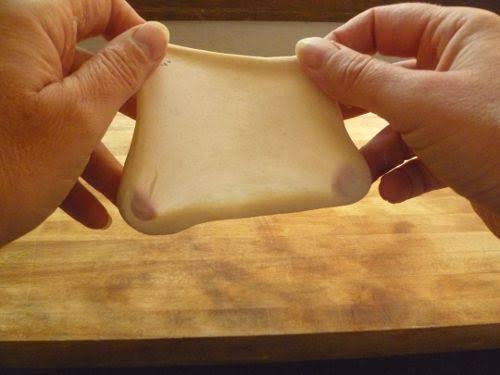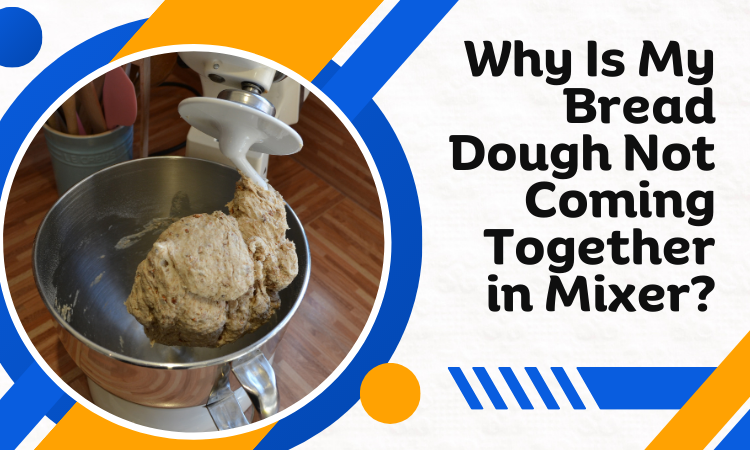One of the most common problems that breadmakers encounter is when their dough does not come out as expected in the mixer. It can be frustrating, especially if you are just starting.
So, why is your bread dough not coming together in mixer?
Your bread dough is not coming together because it may be a bit too dry or perhaps too wet. If it is too wet, you can fix it by putting it into the mixer again and adding some flour. And if it seems to be too dry, follow the same process and add some water and it should be fine.
Well, this is not it. You will be needing more detailed info on this matter to get your dough done nicely. Read this guide to find out how.
Why Is My Bread Dough Not Coming Together in Mixer?
When kneading the dough using a mixer, the dough is supposed to form a ball. Also, no batter or flour should be sticking to the mixing bowl.
If it is not the case, there can be two possible reasons behind it.
That is, the dough you are kneading might either be too dry or it is too wet.
If you see the batter sticking to the bowl that means it is too wet. And if you see the flour bits sticking all over the bowl that means the dough is too dry.
What To Do If Your Dough Is Not Sticking Together?
So, How do you make dough stick together more? Well, you may see your dough has not been sticking together or forming a ball, rather you notice the batter sticks to the bowl. This means your dough is too wet.

So, in that case, you need to start your mixer again and this time add some flour. Add one teaspoon at a time and see if it comes together. If it does not, keep adding a spoonful of flour till it does.
Now comes another question, can too much flour make the dough sticky?
Yes, it can. If you notice there are crumbly bits all over the mixing bowl as you knead your dough, that means it is very dry.

So, similarly, you need to start the mixer and add some water to the dough. One spoonful of water at a time. Then continue to knead. Now see if the dough sticks together nicely. If not, keep adding a teaspoon of water till it does.
How Long Should You Knead Dough in Stand Mixer?
Turn your mixer on to the lowest setting. Let the dough knead for 3 minutes or until it sticks to the hook and cleans the sides of the bowl. Let it sit for a couple of minutes.
Then again resume kneading for another 3 to 4 min. You will be able to tell if the dough is properly kneaded when it feels smooth and stretchy.
From here you may start inspecting your dough to check if it is ready to work.
it is important to remember that we should use the lowest setting and kneading will take some time. Unlike mixing a cake, kneading bread dough is a lengthy process. it is important to set a timer and stick to it so that we do not rush through the process.
Should You Knead Dough by Hand or Mixer?
When you knead dough that is wet by hand, it can be difficult to handle. And you may feel like adding more flour to make it easier to work with.
However, adding too much flour can change the bread’s texture. And it will also make it hard.
Kneading dough by hand is also messy, leaving flour on the counter and dough stuck to your fingers. Then there is the hassle of cleaning the counter.
Furthermore, if you do it often, you run the risk of developing an injury from the repetitive strain on your hands.
Though hand kneading is quite preferable to some, our recommendation would be using a stand mixer for better efficiency.
A dough hook can do everything your hands would do, but faster. Using a stand mixer with a dough hook will not only save you effort but is also likely to produce better results.
One major benefit of using a stand mixer to knead bread dough is that it simplifies the process for you.
Your hands won’t get messy like it does when hand kneading. And it won’t take up much space on your counter. Stand mixers are also capable of handling sticky doughs with high water content.
If you try to knead the wet dough by hand, it is likely to stick to your fingers. Additionally, a mixer can easily knead heavy dough that would be too much for your hands to handle.
How to Knead Dough With A Mixer?
Follow this process accordingly to knead the dough with a mixer properly.
- To begin, follow the instructions of the recipe you are making for mixing the ingredients.
- Then take off the mixing attachment by compressing the spring. Do it by pushing up on the attachment. Then twist it to unlock, and slide it off the pin.
- Next, attach the dough hook. Start off by sliding it onto the pin. And then compressing the spring by pushing up and twisting the hook. It will then allow the spring to decompress and the hook will lock into place.
- To knead yeast dough using the dough hook, set the mixer speed for bread dough at 2. Then knead for around 2 minutes to initially mix the ingredients.
Now stop the mixer, then scrape and clean the sides of the mixing bowl. Resume your mixing for another 3 to 5 min until it becomes smooth and elastic.
- If you are using a hand mixer, set it to speed 2. Then knead the dough for 3-5 minutes until the dough forms a ball and clings to the sides of the bowl.
How To Tell If Dough Is Kneaded Enough?
The dough needs to pass the Windowpane Test for you to be able to tell if it is kneaded enough. Bread not passing the windowpane test means it is not kneaded enough.
To do that, take a ball-size of dough and then stretch it in between your fingers.
If the dough tears apart, it means that there is not enough gluten formed in the dough yet. This indicates that it needs more kneading.
However, If the dough stretches without breaking, it forms a sort of “windowpane” shape.

This indicates that you have kneaded the dough enough, and it is ready to rest.
You may ask, should bread dough be sticky after kneading?
No, it should only be sticky as you start to knead. But when you are done with the kneading, it should not be sticky.
What Happens If You Over-Knead Bread Dough?
Over-kneaded dough makes bread tough, with a hard crust and crumbly texture.
You do not want to end up with tacky dough, do you?
Unfortunately, there is no way to undo over kneaded dough. But you can let it rise longer than usual to help relax the tight gluten strands.
When the dough is over-kneaded, it feels tough and dense to the touch, making it difficult to flatten and fold. And it also tears easily.
If you are kneading the dough by hand, you are unlikely to over-knead it because your arms will get tired before that happens.
However, if you are using a machine to knead the dough, you need to check it every 2-3 minutes. Just to make sure it does not become over-kneaded.
Frequently Asked Questions (FAQs):
How long does it take to knead dough by hand?
To make the dough by hand, you need to knead it for up to 25 minutes using your forearm muscles. This can be tiring, but it is doable. However, depending on person to person it may take more or less time.
Does kneading help bread rise?
Yes, kneading does help your bread rise. It involves stretching and developing the gluten strands in the dough. These protein strands align and form a gluten matrix in the bread that traps air, allowing the bread to rise.
What makes bread light and fluffy?
The bubbles created by carbon dioxide make your bread light and fluffy. These bubbles create holes in the bread, making it lighter and fluffier. Yeast growth is the cause of the gas that creates the bubbles. As the yeast grows more, more gas is produced in the dough, resulting in a bread loaf that is lighter and more airy.
Wrapping Up
Hope we have resolved your query about why is your bread dough not coming together in mixer?
Remember, bread-making requires patience and practice, but with the right techniques and mindset, the results can be incredibly satisfying. Surely this guide is gonna help you solve your dough kneading problems.
That is it as of today. Enjoy the day!




